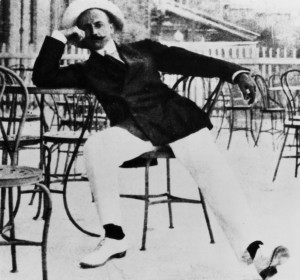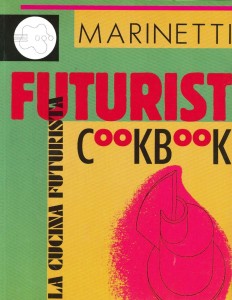Bartender, There's an Anchovy In My Drink
When I first heard about a bartender at an art museum who was himself an exhibit, someone who crafted molecular cocktails in which the drinker’s psychological mood was a key ingredient, I admit I sort of rolled my eyes at just how out of control and comical these complicated, novel variations on mixing a drink had become. Little did I know that there was already a substantial foundation for such mixological tomfoolery, reaching as far back as the early 20th century. At the 2014 Tales of the Cocktail seminar Italian Futurism (1909-1944): Art+Drink, introduced by Haus Alpenz founder Eric Seed and featuring speakers Roberto Bava, Managing Director at Giulio Cocchi Spumanti, and Fulvio Piccinino, author of the The Futurist Mixology, an upcoming book about Futurist cocktails published by CocchiBooks, I learned that the fiddly foundations of “spray 10ppm lavender salmon bitters into 64 degree air; one hour later, in a whisper, suggest to a coupe glass the emotion of that spritz as it fell to earth” theatrical bartending (surely our modern version of “Tom Cruise is flipping the bottles around again”) grew from Italian Futurists, a movement I’d known as touching art, design, architecture, and literature but had no idea also tried its hand at mixing drinks.
The Futurists, founded in 1909 by poet Filippo Tommaso Marinetti, sought nothing less than a complete and total break with the past -- rather radical an idea, given that Italy possessed no small quantity of historical past -- and force Italy, and humanity, into the future. It was, in many ways, a reaction to the Decadence movement championed by writers like Gabrielle D’Annunzio and which stressed romanticism and rosy longing. Marinetti, in contrast, railed against such winsome nostalgia. He thought Italy should demolish the Coliseum, for example, and ban that tired old food known as spaghetti. Food should come in awesome pill form. Construction should follow function and use modern materials like plastic and steel and glass. He admired speed, noise, and youth. airplanes and automobiles and industry.
Lesser known however were Futurist forays into cocktails, or polibibita as they called them. For Futurist drink makers -- almost no one who created Futurist cocktails had experience as a bartender, as some of the combinations can show -- cocktails should not be about familiar ingredients or flavor combinations. One of sour, two of sweet? How about two of bitter, one of bitter, one of machine oil, and something to do with two pieces of sheet metal being dragged across one another? Polibibita were meant to evoke a reaction, inspire thought, perhaps even shock and outrage the drinker. Anything to shake off the fetters of the past. And they were meant to inspire certain philosophical reactions or physical tasks. Decisoni, to aid in making important decisions; inventine, refreshing and intoxicating so that the imbiber will be inspired to new ideas and new ways of thinking; prestoinletto, for when it’s cold outside; guerrainletto, or “war in bed,” for when you need to be energetic and virile for a night’s raucous lovemaking; and paceinletto, “peace in bed,” when -- as Fulvio Piccinino described it -- “you are alone in bed and have no partner. You just need to fall asleep.”
The Futurist movement didn’t survive much past the outbreak of World War II, and while their art and design and philosophy remains in the public consciousness, their food and drink theory is more obscure, even among people who specialize in obscure theories of food and drink. This is probably partly because some of the cocktails were just horrible. But it’s also because part of the philosophy of mixing polibibta was that no recipes or methods should ever be written down. To do so would lock the drinker into a rigid formula, eliminate the possibility that making a mistake could result in the creation of an entirely new libation. And so, while general descriptions and components survive (probably etched by robots with acid-tipped pens onto thin sheets of metal, the material Marinetti thought books should be made from), portions and methods were never recorded. In fact, it has been Piccinino’s mission to research these Futurist cocktails and, much to the consternation of Marinetti’s ghost I am sure, develop sound -- or at least interesting -- polibibita recipes out of the scant info the Futurists left behind.
To illustrate the points of the seminar, we were served a variety of cocktails. Most of them were at least somewhat familiar, using ingredients like Campari and other popular Italian bitters. We were even given small strips of sandpaper, cork, and satin, so that we might indulge in tactile reaction to each of the drinks. But then came the last one, the one Piccinino and Bava had warned us about, snickered about serving us. “I think I should film your reaction to it,” Piccinino joked. And so we received a colorless cocktail using grappa as its base, maybe ever so slightly clouded by the inclusion of a triangle of anchovy floating in it.
And I have to say, if the Futurists’ idea was that my polibibita should inspire a strong reaction and spark deep thought, in at least some regard they succeeded. My strong reaction was desperately reaching for the Campari cocktail to wash away the taste of the last one. And my deep thought was, “I am enriched by this experience and look forward to never drinking a fish cocktail ever again.”



